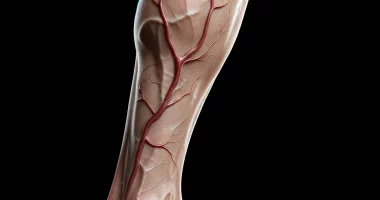Kyphosis
Definition
Kyphosis is a spine curvature in the anteroposterior (sagittal) plane. It can be both physiologic and pathologic. Pathologic kyphosis more often develops in the thoracic region, often accompanied by back pain. With significant curvature, compression of nerve roots and spinal cord with corresponding symptoms (weakness in the legs, sensory disorders, pelvic disorders) is possible. In particularly severe cases, heart and lung disorders may be observed. It is diagnosed based on external examination and radiography. Treatment of kyphosis is mainly conservative. In certain situations, surgery is indicated.
General information
Kyphosis is both pathologic and physiologic curvature of the spine in the anteroposterior direction. Physiologic kyphosis is determined in all people with the thoracic spine. Pathology occurs when the angle of curvature is 45 degrees or more. Kyphosis can be observed both separately and in combination with scoliosis (curvature of the spine in the lateral plane). The most common cause of pathologic kyphosis is vertebral fractures.
Kyphosis can be angular or arched depending on the curvature’s nature. Angular kyphosis usually occurs in spinal tuberculosis, accompanied by the formation of a hump, shortening of the torso, and protrusion of the chest forward. In arcuate kyphosis, the entire thoracic spine has a smooth C-shaped deformity.
Causes of kyphosis
Pathology can occur due to intrauterine development disorders, unfavorable heredity, traumas and spinal surgeries, weakness of the back muscles due to insufficient physical activity, etc. In older people (especially women), kyphosis often develops due to pathologic compression fractures of the thoracic vertebrae. The cause of such fractures is osteoporosis – a decrease in bone density.
In addition, kyphosis can form in some infectious and non-infectious diseases: spondylitis, ankylosing spondylitis (Bechterew’s disease), and spinal tumors. Very rarely, radiation therapy performed for the treatment of malignant neoplasms in childhood causes pathologic kyphosis.
Classification
Taking into account the cause of occurrence in orthopedics and traumatology, the following varieties of pathological kyphosis are distinguished:
- functional kyphosis;
- dorsal juvenile kyphosis (develops in Scheiermann-Mau disease);
- congenital kyphosis;
- paralytic kyphosis;
- post-traumatic kyphosis;
- degenerative kyphosis.
Considering the curvature angle, standard, increased (increased angle), and straightened (reduced angle) kyphosis are distinguished.
Enhanced kyphosis, in turn, is subdivided into three degrees:
- First degree in which the bending angle is 35 degrees or less.
- Second degree, in which the angle of curvature ranges from 31 to 60 degrees.
- Third degree, in which the bending angle is 60 degrees or more.
Types of kyphosis
Functional kyphosis
Functional kyphosis is a manifestation of incorrect posture. It occurs due to poorly developed back muscles or an unphysiological position during study or work. The body strives to compensate for the excessive backward bending of the thoracic spine, so this kyphosis often results in concomitant lumbar hyperlordosis (excessive forward bending of the lumbar spine).
Unlike other types of kyphosis, the excessive curvature disappears when trying to straighten the back or lying on a hard, flat surface in this pathology. X-rays do not show any abnormalities. Treatment of functional kyphosis is conservative. The patient is taught to maintain the correct position while sitting, standing, and walking. Specially designed sets of exercises are prescribed to strengthen the back muscles. Wearing corsets is not indicated.
Dorsal adolescent kyphosis.
The causes of this form of kyphosis (Scheiermann-Mau disease) are not fully understood, but hereditary predisposition certainly plays a role in its development. It is assumed that kyphosis, in this case, occurs either due to avascular necrosis of the closure plates (layers of hyaline cartilage between the vertebra and the intervertebral disc) or due to excessive bone growth in the vertebral bodies. There is also a suggestion that kyphosis develops because of multiple microfractures of the vertebrae due to osteoporosis.
Dorsal adolescent kyphosis is diagnosed based on anamnesis and clinical and radiographic examination. In some cases, electroneuromyography and MRI of the spine are additionally performed. Treatment is usually conservative. Massage, physiotherapeutic procedures, and manual therapy are prescribed, sometimes wearing a corset. The indications for surgery are a large angle of curvature (more than 75 degrees), persistent pain syndrome, and respiratory and circulatory disorders.
Congenital kyphosis
Congenital kyphosis is a consequence of abnormal embryonic development. It occurs when anomalies occur at the stage of vertebral formation, which may result in the formation of butterfly-shaped or wedge-shaped vertebrae, posterior semi-vertebrae, microvertebrae, etc. Segmentation disorders into individual vertebrae are less common.
Often (about 13% of cases), kyphosis is combined with other anomalies of the spinal canal (dermoid cysts, fibrous tautness, dermal sinuses, abnormal spinal roots, etc.) and developmental disorders of various organs and systems (urinary, cardiopulmonary, limbs, abdominal, and thoracic wall).
Radiography (review and targeted images in various projections), CT, and MRI are used as additional methods of investigation. An X-ray contrast examination of the spinal canal may be prescribed. A neurological examination is mandatory. Conservative treatment of congenital kyphosis is ineffective. Surgical intervention in childhood is recommended to eliminate pathological kyphosis, stabilize the spine, and prevent its further deformation.
Post-traumatic kyphosis
Fractures of the thoracic and lumbar vertebrae are the most common cause of kyphotic deformity (about 40% of all kyphosis). The risk of kyphosis depends on the severity of the injury, musculoskeletal disorders (osteoporosis, weakness of the back muscles), and compliance with medical recommendations during treatment. The relevant history, clinical signs, and radiologic signs of post-traumatic kyphosis are the basis for diagnosis.
In some cases, kyphosis is combined with neurological disorders. Treatment is predominantly surgical. If there are contraindications to surgery (advanced age, severe comorbidities, etc.), conservative therapy is performed, and a corset is prescribed.
Diagnosis
Diagnosis begins with a detailed interview and examination of the patient. The doctor studies the history of the disease, clarifies the features of the pain syndrome, and pays attention to the absence or presence of neurological disorders. The examination includes palpation of the back and neck, determination of muscle strength, and skin sensitivity. The specialist examines tendon reflexes, conducts special tests to assess the neurological status, and performs auscultation of the heart and lungs.
An obligatory stage of the examination is radiography of the spine, which may include both overview direct and lateral images, as well as targeted radiographs in non-standard projections and a specially selected position of the patient (for example, in conditions of spinal extension).
MRI may be prescribed to detect pathology in soft tissues. To assess pathologic changes in bone structures, the patient may be referred for a CT scan.
Treatment of kyphosis
Treatment is more often conservative and includes therapeutic exercises to strengthen the muscular corset of the back, massage, and physiotherapy. Manual therapy is indicated for some patients. Wearing a corset is prescribed mainly to reduce pain. However, permanent use of corsets is not recommended in most cases, as they do not correct posture by themselves and, in addition, may cause weakening of the back muscles with subsequent aggravation of kyphosis.
The indication for surgical intervention is:
- Persistent pain syndrome that conservative methods cannot eliminate.
- Rapid progression of kyphosis, especially – accompanied by neurological disorders, as well as lung and heart dysfunction.
- A cosmetic defect that significantly reduces the patient’s quality of life and prevents the patient from performing professional duties.
The goal of the surgery is to correct the angle of the spine as much as possible and stop the progression of the deformity. It also aims to eliminate compression of nerve trunks and protect them from future damage. Surgical operations on the spine belong to the category of complex, large-scale interventions and are performed under general anesthesia only after a complete patient examination. Sometimes, several surgeries are required to achieve the desired result.
Various structures made of inert metals (titanium, titanium nickelide) are used to fix the spine. They do not cause a rejection reaction and can remain in the body without consequences for many years.
All these treatment options are available in more than 790 hospitals worldwide (https://doctor.global/results/diseases/kyphosis). For example, Spinal deformity correction can be performed in these countries for following approximate prices:
Turkey $14.8 K in 30 clinics
Israel $20.7 K – 59.8 K in 13 clinics
Germany $49.5 K in 25 clinics
China $49.9 K in 7 clinics
United States $75.7 K in 17 clinics.

